Chatham
New road
31 High street, Old Brompton
Fort Pitt Hill / Boundary road
Albany terrace
31 High street, Old Brompton
Fort Pitt Hill / Boundary road
Albany terrace
'Royal East Kent (Duke of Connaught's Own (Mounted Rifles), (A Squadron); Drill hall, New road.'
'Kent Royal Garrison Artillery; head quarters [and No. 1 Company], 31 High street, Old Brompton, Chatham.'
'Home Counties (Kent) Heavy Battery Royal Garrison Artillery: Right half Battery and Ammunition Column.'
'5th Battalion The Queen's Own (Royal West Kent Regiment), F&G Cos.; head quarters, Albany terrace.'
'Kent Cyclist Battalion ([section] C Company), Drill hall, Boundary road.' Listed elsewhere as a section of D Company
'1st Home Counties Field Ambulance Royal Army Medical Corps (C Section)
All the above references are taken from Kelly, 1913.
Kelly, 1903, lists '4th Volunteer Battalion Queen's Own (Royal West Kent Regiment); head quarters, 6a, High street.'
The new Drill Hall on Boundary Road, Fort Pitt was described in detail in the Chatham Observer here. The building included an entrance hall, wide plus separate entrances for sergeants, men and caretaker, Adjutant's room, orderly-room, Colonel's room, Officers' dressing room, offices and armoury. The Sergeants' room was fitted with a private bar and a lavatory annexe. On the opposite side was the men's recreation and reading room, with its own bar and a lavatory annexe.
The drill hall itself was a spacious and airy hall with an open timber roof and measured 70 feet by 120 feet.
Upstairs, the facilities included a billiard room, mess room, caretaker's quarters, kitchen, pantry, and wine store and the drill hall gallery.
In the basement was a band room, Quartermaster's store, coal cellar, ammunition store, machine gun and ambulance room, a beer, wine and spirit cellar with a lift to the bar in the men's room.
The structure of the building is described in the newspaper piece. It was built in the Hennebique system of ferro-concrete construction, which arrived in Britain in 1897 and thus may have been one of the earliest examples.
The new Drill Hall was financed entirely by the local community and cost £8358. Its foundation stone was laid by Lord Roberts on 27th July, 1903 and the building was opened by Lord Methuen in May 1906. Methuen's speech draws attention to resentment at the "immense sums of money [locally] being spent on the Navy and immense sums being spent on the Army for the better housing, better feeding, better clothing, and for the better pay of the Navy and Army." By contrast, "the Volunteers did not get any pay, and this was their little effort to house themselves so that they might make their men more comfortable in their little pleasures, and utilise the fine hall in which they were assembled for the purposes of drill and for making themselves more efficient."
Read the report of the laying of the foundation stone here.
Read the report of the opening here.
Read about the Volunteers Ball in their new Drill Hall, here.
Read about a Sergeants' Dinner held in the new drill hall, here.
The Drill Hall was demolished in February,1933, just thirty years after it was founded with such immense pride.
We are extremely grateful for the considerable help given by the Medway Archives and Local Studies Centre, Strood. We are also very appreciative of the interest taken by Brian Joyce, local author, during my visit to the Local Studies Centre.
'Kent Royal Garrison Artillery; head quarters [and No. 1 Company], 31 High street, Old Brompton, Chatham.'
'Home Counties (Kent) Heavy Battery Royal Garrison Artillery: Right half Battery and Ammunition Column.'
'5th Battalion The Queen's Own (Royal West Kent Regiment), F&G Cos.; head quarters, Albany terrace.'
'Kent Cyclist Battalion ([section] C Company), Drill hall, Boundary road.' Listed elsewhere as a section of D Company
'1st Home Counties Field Ambulance Royal Army Medical Corps (C Section)
All the above references are taken from Kelly, 1913.
Kelly, 1903, lists '4th Volunteer Battalion Queen's Own (Royal West Kent Regiment); head quarters, 6a, High street.'
The new Drill Hall on Boundary Road, Fort Pitt was described in detail in the Chatham Observer here. The building included an entrance hall, wide plus separate entrances for sergeants, men and caretaker, Adjutant's room, orderly-room, Colonel's room, Officers' dressing room, offices and armoury. The Sergeants' room was fitted with a private bar and a lavatory annexe. On the opposite side was the men's recreation and reading room, with its own bar and a lavatory annexe.
The drill hall itself was a spacious and airy hall with an open timber roof and measured 70 feet by 120 feet.
Upstairs, the facilities included a billiard room, mess room, caretaker's quarters, kitchen, pantry, and wine store and the drill hall gallery.
In the basement was a band room, Quartermaster's store, coal cellar, ammunition store, machine gun and ambulance room, a beer, wine and spirit cellar with a lift to the bar in the men's room.
The structure of the building is described in the newspaper piece. It was built in the Hennebique system of ferro-concrete construction, which arrived in Britain in 1897 and thus may have been one of the earliest examples.
The new Drill Hall was financed entirely by the local community and cost £8358. Its foundation stone was laid by Lord Roberts on 27th July, 1903 and the building was opened by Lord Methuen in May 1906. Methuen's speech draws attention to resentment at the "immense sums of money [locally] being spent on the Navy and immense sums being spent on the Army for the better housing, better feeding, better clothing, and for the better pay of the Navy and Army." By contrast, "the Volunteers did not get any pay, and this was their little effort to house themselves so that they might make their men more comfortable in their little pleasures, and utilise the fine hall in which they were assembled for the purposes of drill and for making themselves more efficient."
Read the report of the laying of the foundation stone here.
Read the report of the opening here.
Read about the Volunteers Ball in their new Drill Hall, here.
Read about a Sergeants' Dinner held in the new drill hall, here.
The Drill Hall was demolished in February,1933, just thirty years after it was founded with such immense pride.
We are extremely grateful for the considerable help given by the Medway Archives and Local Studies Centre, Strood. We are also very appreciative of the interest taken by Brian Joyce, local author, during my visit to the Local Studies Centre.
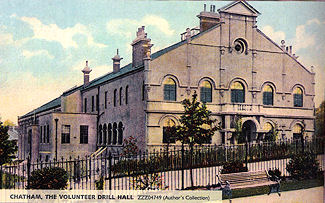
Postcard of Chatham Volunteer
Drill Hall enlarge
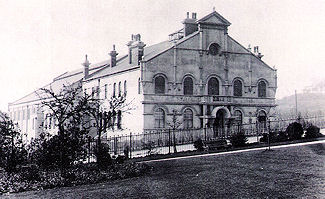
Archive image of Chatham Volunteer
Drill Hall. enlarge
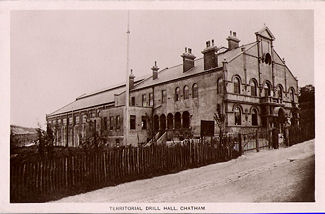
Postcard of Chatham Volunteer
Drill Hall enlarge
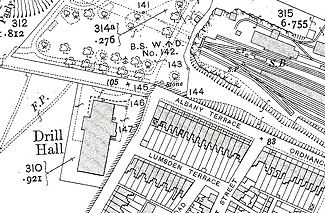
Chatham Drill Hall on 1909 Ordnance Survey View more extensive map
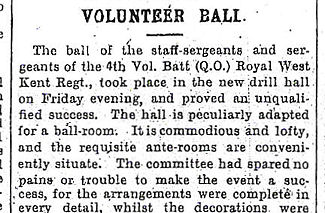
Newspaper report of Chatham Volunteer
Ball View full article
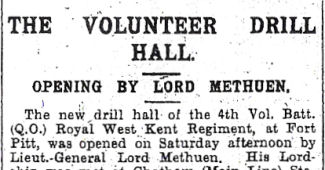
Read the report of the opening
Drill Hall, here
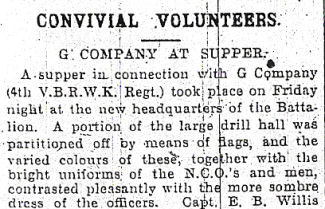
Read about a Dinner held in the new drill hall, here.
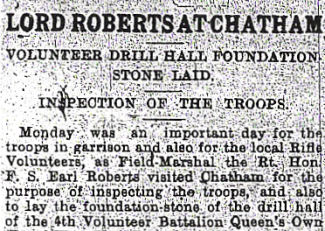
Read the report of the laying of the foundation stone here.
© All material is copyright - refer to the
Terms of Use
the first attempt at content
Introduction
About
Anatomy
Drill
 Database
Database
 Memorabilia
Memorabilia
Resources Glossary
Saving Halls Participate Contact What's New? Terms of Use
Drill
 Database
Database Memorabilia
MemorabiliaResources Glossary
Saving Halls Participate Contact What's New? Terms of Use
The Drill Hall Project - Charting a neglected legacy